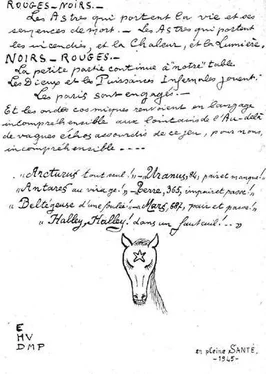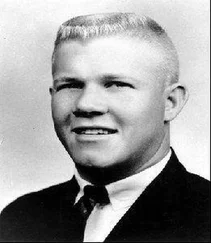The police continued to search for Van Bever in bars, prisons, hospitals, asylums, morgues, and other likely places around the capital and surrounding country, without success. His trial with Petiot, meanwhile, came up, as scheduled, at the Tenth Police Court. Van Bever was pronounced guilty in absentia and sentenced to a year’s imprisonment with a fine of 10,000 francs. He was never found.
As for Jeannette Gaul, she received a fine of 2,400 francs and a sentence of six months in prison, though she would be released after serving only three months (in May 1942), counting from her arrest in February. She returned to the streets and her drug habit, even visiting Dr. Petiot again. She died three months later of tetanus, a complication from an unclean hypodermic needle.
Petiot argued that Van Bever’s disappearance—“he did not dare to show up”—was proof of his own innocence. He was let off with a fine of 10,000 francs, which his lawyer, René Floriot, appealed and soon managed to reduce to 2,400 francs. Dr. Petiot had emerged from a potentially disastrous narcotics charge with his record untarnished.
AS the Van Bever–Gaul investigation was winding down, Petiot was implicated in a second narcotics case. The circumstances were similar. He was allegedly attempting to cure a patient, who had then tried to circumvent his treatment and gain more drugs by deception. But as the case emerged, there would be even more striking similarities.
The patient in the investigation was the twenty-eight-year-old Régine or Raymonde Baudet. In early 1942, when Petiot had prescribed Sonéryl, a mild sleeping pill, Baudet had attempted to replace the word “Sonéryl” with “14 vials of heroin.” The pharmacist on rue des Écoles was not fooled by the unsophisticated tactic. He notified the police. Baudet was taken into custody on March 16, 1942, her fourth arrest on drug charges, two of which had previously led to convictions.
Once again hauled into court for a drug case, Petiot freely admitted trying to cure Baudet of her addiction. He had written four prescriptions for heroin for her already under the name that she had given him, Raymonde Khaït, the last name borrowed from her stepfather. Petiot had refused, he further stated, to write any more prescriptions, offering instead a sedative. It was hardly his fault that his patient, in conjunction with one of her lovers, a man named Daniel Desrouët, had tried to alter his prescription.
There is no evidence that Petiot was involved in the attempted forgery, but what he did next was surprising to say the least, and the case becomes more convoluted. According to the police report filed by Raymonde’s half brother, Fernand Lavie, a thirty-six-year-old clerk at the Préfecture de Police, Petiot went over to the home of their mother, fifty-three-year-old Marthe Antoinette Khaït, at 27 rue de la Huchette, in the Latin Quarter. Passing the cabaret El Djezair in the same building, an Abwehr-controlled establishment, Petiot entered the apartment and berated Khaït for her daughter’s preposterous mistakes. Then Petiot offered to help. They would first need to hire a good attorney, and he offered to pay the expenses.
The physician then advised that Raymonde could best escape a long prison sentence if Madame Khaït claimed that she was herself a drug addict. The authorities would believe it, he explained, because Raymonde had already told the police that she and her mother shared the prescriptions, which had been made to the name of Khaït. Then, to make this claim more credible should the police examine her, Petiot offered to make a dozen injections in her thigh. The injections, he promised, would be innocuous.
Khaït’s son was shocked by the doctor’s proposal. Under no circumstances, he told her, should she be a party to such fraud. Madame Khaït, however, was eventually won over by Petiot’s apparent generosity and adamancy. After many years of helping her daughter, Khaït said that she would not stop now in this time of need. Petiot and Khaït went into another room. A few minutes later, the doctor left the apartment.
At some point that week, probably one or two days later, Khaït decided that she did not want to follow through with their plan and deliberately mislead authorities. Her son had rebuked her for her complicity, as had her husband David and her physician, Dr. Pierre Trocmé, who was appalled to learn about the behavior of his medical colleague. In fact, Trocmé refused to believe that a licensed doctor would give such advice. He urged Madame Khaït to report the matter to the police. If she refused, he would do so himself.
About seven o’clock in the evening of March 25, 1942, Madame Khaït left her apartment, telling her husband that she had to see Dr. Petiot and then stop by the office of her daughter’s lawyer. It would be a quick errand, she said. She did not state the purpose of the visit. Nor did she take any identification papers, ration cards, or even her purse. A large pot of water was boiling on the stove.
On the following morning, when she had still not returned home, an envelope containing two letters had been slipped under the door of Madame Khaït’s residence. One was for her husband David, a Jewish tailor, and the other for her son Fernand. Both were allegedly written by Marthe Khaït. Opening the envelope addressed to himself, David Khaït read with surprise:
Do not trouble yourself on my account. Do not say anything to anybody and above all, don’t go to the police. What I’m doing is in the interest of Raymonde. Dr. Petiot was right. It is better for the police to believe that I am a drug addict. I am not able to withstand an interrogation. I am going to escape to the Free Zone. You will definitely be able to come and join me by adopting the same means. Later, Raymonde will rejoin us
.
Bizarrely, she then confessed to having taken drugs for years as a painkiller for a heart ailment. The letter to Fernand was similar. And both letters bore a striking resemblance to the letter in the Van Bever case, in everything from confession and explanation of the disappearance (which in both cases involved leaving abruptly without packing), to the method and timing of the letters’ delivery (which in both cases had the person signing his or her full legal name). Some experts would extend the similarities further, concluding that the handwriting appeared to be from the same person, though this would be disputed.
The handwriting actually seemed to be his wife’s, David Khaït acknowledged, and he eventually concluded that she had in fact written the letters. He also thought that she had delivered them herself. The family dog, which always barked at the approach of a stranger, had not stirred. Even the stubborn latch on the door in the courtyard had posed no problem. Someone familiar with the building must have delivered the letters. Khaït also recalled his wife’s earlier frustrations about her daughter’s predicament and some conversations when she claimed that she had considered fleeing to the unoccupied zone for the duration of the trial. But at the same time, he knew, she was no drug addict.
Also that morning, two other letters were delivered to the home of Raymonde’s attorney, Maître Pierre Véron. Both of them—one to the attorney, the other to Raymonde—duplicated the information contained in the letters to her family. Three one-hundred-franc notes were enclosed for the attorney’s fee.
The maid, who received the letters, first said they had been delivered by Marthe Khaït. She was certain, she said, because she recognized the woman from previous visits. Later she changed her statement, claiming that the letters were delivered by someone who resembled Madame Khaït. As with the first two letters, the tone of these two was more formal than usual and devoid of the usual nicknames for members of Madame Khaït’s family. Handwriting experts again disagreed on the authenticity of the letters.
Читать дальше












